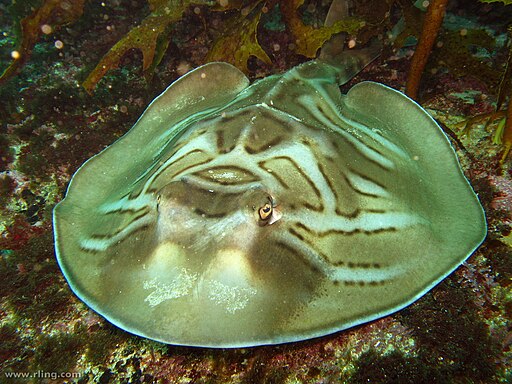Superregnum: Eukaryota
Cladus: Unikonta
Cladus: Opisthokonta
Cladus: Holozoa
Regnum: Animalia
Subregnum: Eumetazoa
Cladus: Bilateria
Cladus: Nephrozoa
Superphylum: Deuterostomia
Phylum: Chordata
Subphylum: Vertebrata
Infraphylum: Gnathostomata
Classis: Chondrichthyes
Subclassis: Elasmobranchii
Infraclassis: Euselachii
Division/Cohort: Neoselachii
Subdivision/Subcohort: Batoidea
Superordo: Batomorphii
Ordo: Rhinopristiformes
Familia: Trygonorrhinidae
Genus: Trygonorrhina
Species: T. dumerilii – T. fasciata – T. melaleuca
Name
Trygonorrhina J. P. Müller & Henle, 1838
Type species: Trygonorhina fasciata Müller & Henle, 1841
Etymology: having the nose of Trygon (= Dasyatis, stingrays) and the tail of Rhinobatos. (From The ETYFish project)
Trygonorrhina fasciata
Vernacular names
Ελληνικά: Τρυγονόρινα
English: fiddler rays, banjo sharks
References
Last, P.R., Séret, B. & Naylor, G.J.P. 2016. A new species of guitarfish, Rhinobatos borneensis sp. nov. with a redefinition of the family-level classification in the order Rhinopristiformes (Chondrichthyes: Batoidea). Zootaxa 4117(4): 451–475. DOI: 10.11646/zootaxa.4117.4.1. Reference page.
Müller, J. & Henle, F.G.J. 1838. On the generic characters of cartilaginous fishes, with descriptions of new genera. Magazine of Natural History [E. Charlesworth, ed.] (n.s.) 2(7): 33–37; 88–91. Reference page.
Trygonorrhina, also known as the fiddler rays or banjo rays, is a genus of guitarfish, family Rhinobatidae. The two species are found along the eastern and southern coasts of Australia. They are benthic in nature, favoring shallow, sandy bays, rocky reefs, and seagrass beds. The eastern fiddler is found to a depth of 120 m and the southern fiddler to a depth of 180 m.[1][2]
The flattened pectoral fin discs of fiddler rays are shorter and more rounded than those of other guitarfishes. Their tails are slender, with a well-developed caudal fin and two triangular dorsal fins.[3] Their snouts are translucent.[1] The fiddler rays are also distinguished from other guitarfishes in that the anterior nasal flaps of their nostrils are expanded backwards and fused together into a nasal curtain that reaches the mouth.[4]
Fiddler rays feed on bottoms shellfish, crabs, and worms, which they crush between their jaws.[1] The eastern fiddler ray is known to scavenge from fish traps.[4] Like other guitarfishes, fiddler rays are ovoviviparous. The egg capsules of the southern fiddler ray are reported to be golden in colour, containing three embryos each.[2] It gives birth to litters of four to six young per breeding cycle.[5] Fiddler rays are harmless and easily approached by divers.[1] Southern fiddler rays are taken as bycatch by commercial trawlers and by recreational fishers; the flesh is of good quality and sold in small quantities.[5] The Magpie fiddler ray (previously Trygonorrhina melaleuca) is now considered a variant of Trygonorrhina dumerilii.[6]
Species
There are currently 2 recognized species in this genus:
Trygonorrhina dumerilii Castelnau, 1873 (Southern fiddler ray)[6]
Trygonorrhina fasciata J. P. Müller & Henle, 1841 (Eastern fiddler ray)
References
Aitken, K. (2002): Southern Fiddler Ray (Trygonorrhina dumerilii) & Eastern Fiddler Ray (Trygonorrhina faciata). Rhinobatidae Archived 4 November 2006 at the Wayback Machine. Marine Themes.
Froese, Rainer; Pauly, Daniel (eds.) (2015). "Trygonorrhina fasciata" in FishBase. April 2015 version.
McGrouther, M. (2006): Eastern Fiddler Ray, Trygonorrhina faciata . Australian Museum.
Compagno, L.J.V.; Last, P.R. (1999). "Rhinobatidae: Guitarfishes". In Carpenter, K.E.; Niem, V.H. (eds.). FAO identification guide for fishery purposes. The living marine resources of the Western Central Pacific. Rome: Food and Agricultural Organization of the United Nations. ISBN 92-5-104302-7.
Huveneers, C. (2015). "Trygonorrhina fasciata". IUCN Red List of Threatened Species. 2015: e.T41866A43270478. doi:10.2305/IUCN.UK.2015-4.RLTS.T41866A43270478.en. Retrieved 13 November 2021.
Donnellan, S.C., Foster, R., Junge, C., Huveneers, C., Rogers, P., Kilian, A. & Bertozzi, T. (2015): Fiddling with the proof: the Magpie Fiddler Ray is a colour pattern variant of the common Southern Fiddler Ray (Rhinobatidae: Trygonorrhina). Zootaxa, 3981 (3): 367–384.
Retrieved from "http://en.wikipedia.org/"
All text is available under the terms of the GNU Free Documentation License


